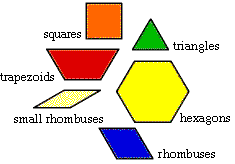





| a tessellation of triangles
|
 |
| a tessellation of squares |  |
| a tessellation of hexagons |  |
When you look at the three examples above,
you can easily see that the
squares are lined up with each other while the triangles and hexagons
are not. Also, if you look at 6 triangles at a time, they form a
hexagon, so the tiling of triangles and the tiling of hexagons are
similar and they cannot be formed by directly lining shapes up under
each other - a slide is involved.
| Regular Polygon |
Measure of each interior angle |
360
degrees ÷ by the measurement of the interior angle |
Will the polygon tessellate using only this polygon? |
|---|---|---|---|
| equilateral triangle | 60 | 360 ÷ 60 = 6 | |
| square | 90 | ||
| regular pentagon | |||
| regular hexagon | |||
| regular heptagon | |||
| regular octagon |
Since the regular polygons in a
tessellation must fill the
plane at each vertex, the interior angle must be an exact
divisor of 360 degrees. This works for the triangle, square,
and hexagon, and you can show working tessellations for these
figures. For all the others, the interior angles are not
exact divisors of 360 degrees, and therefore those figures
cannot tile the plane.
In a tessellation the polygons used will fit together with their angles arranged around a point with no gaps or overlaps. When using just one polygon (for example, only equilateral triangles), the interior measure of each angle will need to be a factor of _____ degrees (meaning that ____ degrees can be divided evenly by that angle measure). The only regular polygons that qualify are the __________________, ___________________, and ___________________.

 |
